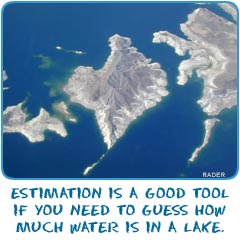
Why is this Important?
Rounding and estimation are important skills in math and every day life. Rounding is a handy tool in the business world for working with amounts. People in a meeting might not want to worry about the exact value of 97. To make things easier, they all agree to round that number up to 100. Its' a lot easier to work with values when they have values rounded to the nearest ten, hundred, or whatever.In math, you can use estimation to give you an idea about the possible answer without doing a lot of work. While you solve the full problem, you will know if you're on the right track. In daily life, estimation is great for giving intelligent guesses about possible amounts. You might see a pile of boxes and estimate that there are about 2,500 toys. It's okay if the actual number is 2,479. You were close enough for a quick idea.
Rounding Basics
In math, you can round up or round down. Rounding up happens when you have a value that is half or greater of the amount you are rounding. Let's say you want to round to the nearest ten. If you were given the value 26, you would round up because 6 is greater than half of ten (5). If you were given 25, you would also round up. Rounding down happens when the value is less than half. Using the same examples, if you were given the number 24 you would round down because the four is less than five. Even if you were given the wacky decimal 24.9999, you would still round down because 4.9999 is less than five. Here are some more examples:Round 34 to the nearest 10 -- 30
Round 678 to the nearest 10 -- 680
It works for hundreds and thousands too.
Round 494 to the nearest 100 -- 500
Round 627 to the nearest 100 -- 600
Round 5,872 to the nearest 1,000 -- 6,000
Round 8,452 to the nearest 1,000 -- 8,000
Related Activities

|
Round to the Nearest Tenth Memory Challenge
- Play Activity |

|
Quiz for Rounding to the Nearest Hundredth
- Play Activity |
Estimation Basics
Estimation is a process based on the rounding of numbers. Estimation is often used when you are doing arithmetic with long numbers. If you had the problem 567 + 248 and you only needed a close answer, you could estimate. That example might have you changing the values to 600 + 200 or 570 + 250. Your teacher would tell you where to round off (10s or 100s). Your first step was to round off both numbers to a specific place, and then you do the math. Your answer would be an estimation of the actual answer. You need to remember that estimation can give you answers that are very different from the actual answer. In our example, you might have estimated 800 or 820. With the actual answer of 815, you can see how the estimations were a bit off. Here are two more examples:237 + 469 = ?
Rounding to 10: 240 + 470 = 710
Rounding to 100: 200 + 500 = 700
Actual answer: 706
864-202 = ?
Rounding to 10: 860 - 200 = 660
Rounding to 100: 900 - 200 = 700
Actual Answer: 662
In the first example you were pretty close in either try. The second example shows how far off you can be from the actual answer. 700 is nowhere near the real answer of 662.
Related Activities

|
Estimates Sums to the Nearest Ten
- Play Activity |

|
Estimate Differences to the Nearest Hundredth
- Play Activity |
► NEXT PAGE ON FRACTIONS & DECIMALS
► NEXT STOP ON SITE TOUR
► RETURN TO TOP OF PAGE
► Or search the sites...
► NEXT STOP ON SITE TOUR
► RETURN TO TOP OF PAGE
► Or search the sites...

- Overview
- Number Types
- Factors
- Fractions
- Decimals
- Percentages
- Estimation
- Ratios
- Money
- Activities
- More Maths Topics

Useful Reference Materials
Wikipedia:https://en.wikipedia.org/wiki/Fraction_%28mathematics%29
Encyclopædia Britannica:
http://www.britannica.com/topic/fraction
University of Delaware:
https://sites.google.com/a/udel.edu/fractions/



